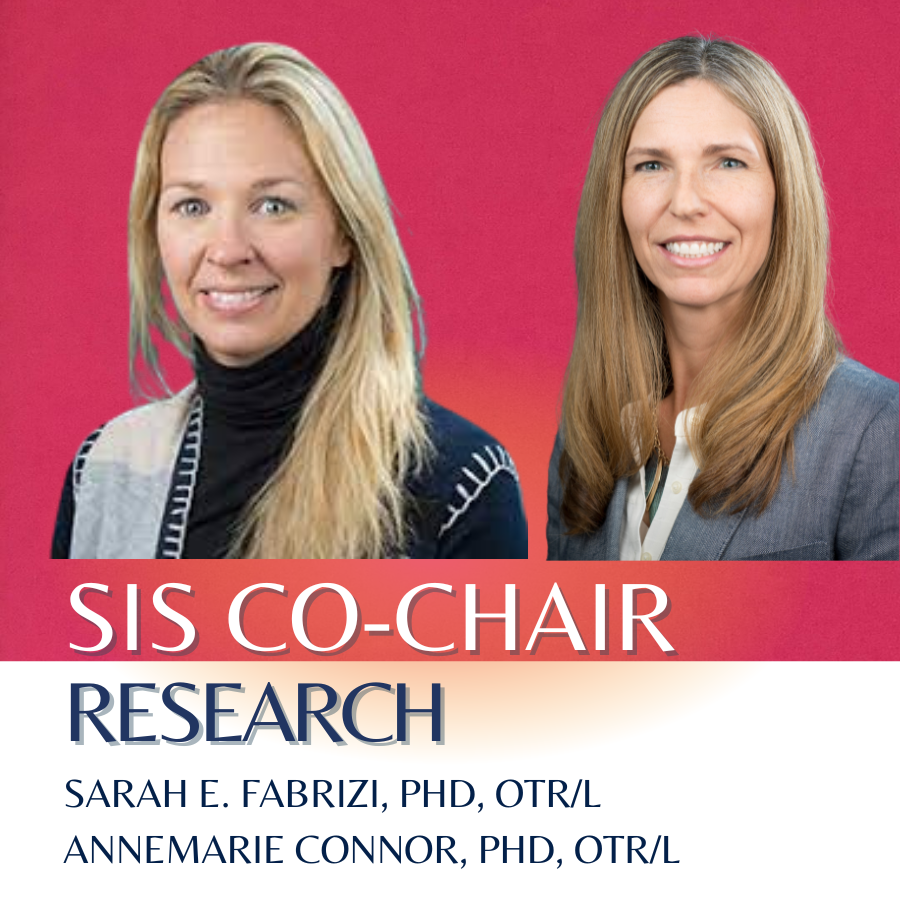Trends in Occupational Therapy Research and Practical Applications for Providers
 Trends in Occupational Therapy Research and Practical Applications for Providers
Trends in Occupational Therapy Research and Practical Applications for Providers
Research Special Interest Section
Sarah E. Fabrizi, PHD, OTR/L
Annemarie Connor, PHD, OTR/L
Occupational therapy plays a crucial role in enhancing the quality of life for individuals across various age groups and populations, with significant advancements in occupational therapy research leading to improved interventions, outcomes, and understanding of human occupation. The emphasis on evidence-based practice (EBP) continues, producing better outcomes for clients in a more cost-effective way (Connor et al., 2023). The Centers for Medicare & Medicaid Services (CMS) cited American Occupational Therapy Association’s (AOTA) Practice Guidelines as "relevant and credible" in a proposed rule released in 2021. AOTA's Practice Guidelines are based on the findings of systematic reviews and describe clinical recommendations. This article will provide a brief review of trends seen in occupational therapy research along with practical suggestions to support occupational therapy providers as they translate research knowledge into everyday practice.
Exploring the integration of technology, such as telehealth, virtual reality, and wearable devices, into occupational therapy practice is a growing area of interest. A systematic review of telehealth interventions within the scope of occupational therapy practice found statistically significant improvements in areas of occupational performance and associated client factors overall (Feldhacker et al., 2022). It was noted that careful consideration should be given to the focus of intervention, as a strong strength of evidence supports the use of telehealth approaches for people with neurological and pain conditions, moderate strength of evidence supports the use of telehealth interventions to support education outcomes, and low strength of evidence was found for other outcomes for children with developmental disorders and additional conditions. Reviews of the use of virtual reality for children with cerebral palsy (Bell et al., 2024), for treatment of anxiety disorders (Donnelly et al., 2021), and adults with stroke (Goldberg, 2023) provide promising evidence for the use of simulation environments that improve motor performance and activities of daily living outcomes. Wearable devices have shown promise in occupational therapy for use in monitoring activity levels, supporting rehabilitation, and promoting independence. Dominguez-Lucio and colleagues (2022) completed a scoping review of occupational therapists’ use of innovative technologies with children and adolescents with autism. Results indicated that OTPs are using a variety of high-tech devices, including augmented and/or virtual reality and multi-user tabletops technology, to engage clients in socialization and collaboration.
There is a need for research focused on promoting occupational justice and social inclusion in occupational therapy practice. Hammell (2021) describes the work of occupational therapy scholars that are critical of dominant theories and models that inform practice yet may have limited relevance in diverse contexts. Research by Murthi & Hammell (2020) concludes that some groups may have few opportunities to make occupational choices. Studies have explored barriers to education (Ramirez & Kiraly-Alvarez, 2023) and participation as well as strategies to promote social inclusion among marginalized populations, including those living in non-urban settings (Hayes et al., 2023). Addressing disparities in occupational participation and promoting social inclusion among diverse populations are important research priorities, and scholars in the field urge providers to carefully consider cultural, contextual, and environmental impacts.
Mental health disorders are now among the most common disorders in the US. Approximately 1 in 5 adults in the US live with a mental illness and 1 in 5 youths (ages 13-18) have, or have had, a “seriously debilitating mental illness” (CDC, 2023). In response, research in occupational therapy has focused on developing innovative interventions to support individuals with mental health challenges. A scoping review of occupational therapy intervention for children and youth with and at risk for mental health concerns reports moderate to strong evidence for yoga, sports, as well as moderate support for play and creative arts (Cahill et al., 2020). A review of interventions to improve occupational performance and participation for adults with serious mental illness by D’Amico et al. (2018) provides strong evidence to support the use of psychoeducation and occupation and cognitive-based interventions, as well as moderate evidence for skills-based intervention. Studies focusing on mental well-being, recovery, and the role of occupational therapy in mental health care are essential.
Collaboration with other healthcare professionals is critical for occupational therapy providers to deliver a client-centered approach. Studies have described collaboration in research, practice, as well as interprofessional work and education. Sawanda et al. (2023) performed a scoping review to identify attributes of collaboration on occupational therapy to include: active participation for the common objective, existence of something to share, matured communication and interaction, relationship founded on the respect and trust, and complementing each other. Research on effective interprofessional collaboration models, communication strategies, and teamwork in occupational therapy practice is important for enhancing the quality of care provided to clients.
As the field of occupational therapy continues to evolve, driven and shaped by research and a commitment to enhancing the well-being of individuals through meaningful occupation occupational therapy practitioners can obtain and utilize research in the following ways:
1. Continuing Education: Attend conferences, workshops, and seminars to stay updated on the latest research findings in occupational therapy. Many professional organizations (such as Florida Occupational Therapy Association (FOTA), AOTA) offer continuing education opportunities that focus on evidence-based practice and research in the field. Vet continuing education providers by looking for providers that link learning to evidence and provide references to relevant, peer-reviewed studies.
2. Accessing Journals and Publications: Subscribe to occupational therapy journals and publications to access the latest research articles. Online databases such as PubMed, OTseeker, and CINAHL provide access to a wide range of research studies relevant to occupational therapy practice. Google Scholar is a rich and reputable source of research literature and is free.
3. Joining Research Networks & Seek Research Mentors: Participate in research networks and collaborations to stay connected with researchers and practitioners in the field. Networking with colleagues who are actively involved in research can provide opportunities to access and discuss current research findings.
4. Utilizing Evidence-Based Practice Resources: Use evidence-based practice resources such as clinical practice guidelines, systematic reviews, and research summaries to inform clinical decision-making. Websites like the AOTA offer resources to support evidence-based practice in occupational therapy.
5. Engaging in Research Projects: Participate in research projects or collaborate with researchers to contribute to the generation of new knowledge in occupational therapy. Involvement in research studies can enhance practitioners' understanding of research methods and findings, as well as provide opportunities to apply research findings in clinical practice.
6. Implementing Research Findings in Practice: Translate research findings into clinical practice by incorporating evidence-based interventions and approaches into treatment plans. By staying informed about the latest research, practitioners can ensure that their interventions are based on the best available evidence and are tailored to meet the needs of their clients.
7. When working with clients and caregivers who request implementation of interventions currently lacking moderate to strong research evidence, practitioners are ethically obligated to inform stakeholders that the intervention is experimental. Such experimental, non-evidence-based approaches should only be offered if there is little to no risk of harm. Partnering with a professional researcher, through a university or health system, is key to raising awareness and vetting experimental interventions. All EBPs were at one point experimental!
8. Reflecting on Practice: Reflect on clinical experiences and outcomes to identify areas for improvement and opportunities for further research. Practitioners can use their own practice data to inform research questions and contribute to the evidence base in occupational therapy. By actively engaging with research, occupational therapy practitioners can enhance their clinical practice, improve client outcomes, and contribute to the advancement of the field. Staying informed about the latest research findings and incorporating evidence-based approaches into practice can help practitioners deliver high-quality, effective care to their clients.
References
Bell, J., Decker, B., Eichmann, A., Palkovich, C., Reji, C. (2024). Effectiveness of virtual reality for upper extremity function and motor performance of children with cerebral palsy: A systematic review. American Journal of Occupational Therapy, 78(2), 7802180180. https://doi.org/10.5014/ajot.2024.050374
Connor, L., Dean, J., McNett, M., Tydings, D. M., Shrout, A., Gorsuch, P. F., Hole, A., Moore, L., Brown, R., Melnyk, B. M., & Gallagher-Ford, L. (2023). Evidence-based practice improves patient outcomes and healthcare system return on investment: Findings from a scoping review. Worldviews on Evidence-Based Nursing, 20, 6–15. https://doi.org/10.1111/wvn.12621
Domínguez-Lucio, S., Compañ-Gabucio, L. M., Torres-Collado, L., & de la Hera, M. G. (2023). Occupational therapy interventions using new technologies in children and adolescents with autism spectrum disorder: a scoping review. Journal of Autism and Developmental Disorders, 53(1), 332-358.
D’Amico, M., Jaffe, L., Gardner, J. (2018). Evidence for interventions to improve and maintain occupational performance and participation for people with serious mental illness: A systematic review. American Journal of Occupational Therapy, 72(5), 7205190020p1– 7205190020p11. https://doi.org/10.5014/ajot.2018.033332
Feldhacker, D. R., Jewell, V. D., Jung LeSage, S., Collins, H., Lohman, H., & Russell, M. (2022). Telehealth interventions within the scope of occupational therapy practice: A systematic review. American Journal of Occupational Therapy, 76(6), 7606205090. https://doi.org/10.5014/ajot.2022.049417
Goldberg, C., Winterbottom, L., Geller, D., Nilsen, D. Mahoney, D., Gillen, G. (2023) Technology-related interventions to improve performance in activities of daily living for adults with stroke. American Journal of Occupational Therapy, 77(Supplement 1), 7710393020. https://doi.org/10.5014/ajot.2022.77S10002
Centers for Disease Control. (2023, April 15). About Mental Health. https://www.cdc.gov/mentalhealth/learn/index.htm#:~:text=More%20than%201%20in% 205,a%20seriously%20debilitating%20mental%20illness.&text=About%201%20in%202 5%20U.S.,bipolar%20disorder%2C%20or%20major%20depression.
Hammell K. W. (2021). Social and structural determinants of health: Exploring occupational therapy's structural (in)competence. Canadian Journal of Occupational Therapy. Revue canadienne d'ergotherapie, 88(4), 365–374. https://doi.org/10.1177/00084174211046797
Hayes, K., Dos Santos, V., Costigan, M., & Morante, D. (2023). Profile of occupational therapy services in non-urban settings: A global scoping review. Australian Occupational Therapy Journal, 70(1), 119–141. https://doi.org/10.1111/1440-1630.12835
Murthi, K. & Hammell, K. W. (2021) ‘Choice’ in occupational therapy theory: A critique from the situation of patriarchy in India, Scandinavian Journal of Occupational Therapy, 28:1, 1-12, https://doi.org/10.1080/11038128.2020.1769182
Ramirez, A., & Kiraly-Alvarez, A. F. (2023). Exploring supports and barriers to inclusion in occupational therapy education. Journal of Occupational Therapy Education, 7 (4). https://doi.org/10.26681/ jote.2023.070404
Sawada, T., Oh, K., Namiki, M., Tomori, K., Ohno, K., & Okita, Y. (2023). The conceptual analysis of collaboration in occupational therapy by combining the scoping review methodology. International Journal of Environmental Research and Public Health, 20(11), 6055. https://doi.org/10.3390/ijerph20116055
